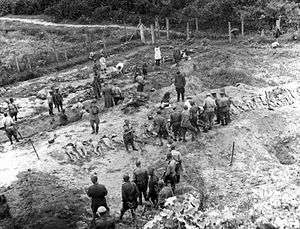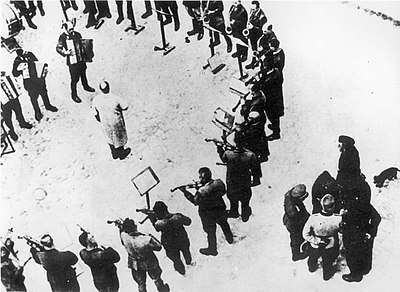Janowska concentration camp
Janowska concentration camp (Polish: Janowska, Russian: Янов or "Yanov", Ukrainian: Янівський табір) was a Nazi concentration camp combining elements of labor, transit and extermination camps. It was established in September 1941 on the outskirts of Lwów in Eastern Poland / Western Ukraine (today: Lviv, Ukraine). The camp was named after the nearby street Janowska in Lwów of the interwar Second Polish Republic.
| Janowska concentration camp | |
|---|---|
| Concentration camp | |
 Survivors of the camp's Sonderkommando 1005 unit stand next to a bone crushing machine (taken following the liberation of the camp in 1944) | |
 Location of Janowska camp in modern Ukraine
Janowska
south of the Belzec death camp | |
| Coordinates | 49°51′15″N 23°59′24″E |
| Location | Lemberg, District of Galicia, General Government (formerly Lwów, Second Polish Republic; today Lviv, Ukraine) |
| Operated by | SS |
| Operational | September 1941 – November 1943 |
| Inmates | Jews |
| Number of inmates | 100,000 |
| Killed | 35,000–40,000 |
| Liberated by | The Red Army |
| Website | encyclopedia |
The camp was liquidated in November 1943, with the evidence of mass murder being largely destroyed in the Nazi program of Sonderaktion 1005. Estimates put the total number of prisoners who passed through the Janowska camp at between 100,000 and 120,000, mostly Polish and Soviet Jews.[1] The number of victims murdered at the camp is estimated at 35,000–40,000.
Background
Lwów (Lviv) was a multicultural city just before World War II, with a population of 312,231. The city's 157,490 ethnic Poles constituted just over 50 per cent, with Jews at 32 per cent (99,595) and Ukrainians at 16 per cent (49,747).[2] On 28 September 1939, after the joint Soviet-German invasion, the USSR and Nazi Germany signed the German–Soviet Frontier Treaty, which assigned about 200,000 km2 (77,000 sq mi) of Polish territory inhabited by 13.5 million people of all nationalities to the Soviet Union. Lviv was then annexed to the Soviet Union as part of the Ukrainian SSR.[3]
At the time of the German attack on the Soviet Union in June 1941, about 160,000 Jews lived in the city;[4] the number had swelled by tens of thousands due to the arrival of Jewish refugees from German-occupied Poland in late 1939.[5] Lviv was occupied by the Wehrmacht on 30 June 1941. Jews were press-ganged by the Germans to remove bodies of the victims of the NKVD prisoner massacres ,for which Nazi propaganda and Ukrainian nationalists blamed the Jews.[6] In the ensuing July pogroms and the concurrent Einsatzgruppen killings, thousands of Jews were murdered.[5]
Lwów Ghetto
In early November 1941, the Nazis closed-off northern portions of the city, thus forming the Lwów Ghetto.[7] During the forced relocation of the Jewish families to the newly created ghetto, German police shot and killed thousands of elderly and sick Jews as they crossed under the rail bridge on Pełtewna Street (which came to be known as the bridge of death for the Jews). Several months later, in March 1942, the Nazi police under Fritz Katzmann began to deport Jews from the ghetto to the Belzec extermination camp. By August 1942, more than 65,000 Jews from Lwów had been sent away aboard Holocaust trains and killed. In early June 1943, the Germans destroyed and liquidated the ghetto.[8]
Labour and transit camp
In addition to the Lwów ghetto, in September 1941 the occupation authorities set up a German Armament Works D.A.W. factory (Deutsche Ausrüstungswerke) in prewar Steinhaus Milling Machines Merchants (Maszyny młyńskie - Sprzedaż) on 134 Janowska Street (Grodecka 10a address),[9] in northwestern suburbs of Lwów. This factory became a part of a network of factories owned and operated by the SS. The commandant of the camp was SS-Haupsturmführer Fritz Gebauer. Jews who worked at this factory were used as forced laborers, mainly working in carpentry and metalwork.
In October 1941, the Nazis established a concentration camp next to the factory, which housed the forced laborers along with other prisoners. Thousands of Jews from the Lwów ghetto were forced to work as slave laborers in this complex. When the Lwów ghetto was liquidated by the Nazis, the ghetto's inhabitants who were fit for work were sent to the Janowska camp; the rest were deported to Belzec for extermination. The concentration camp was guarded by a Sonderdienst battalion of the SS-trained Hiwi guards known as "Trawniki men", drawn from Soviet POWs.[10]
In addition to being a forced-labor camp for Jews, Janowska was a transit camp (Durchgangslager Janowska) during the mass deportations of Polish Jews to the killing centers in 1942 from across German-occupied southeastern Poland (now western Ukraine). Jews underwent a selection process in Janowska camp similar to that used at Auschwitz–Birkenau and Majdanek extermination camps. Those classified as fit to work remained at Janowska for forced labor. The majority, rejected as unfit for work, were deported to Belzec and killed, or else were shot at the Piaski ravine, located just north of the camp. In the summer and fall of 1942, thousands of Jews (mainly from the Lwów ghetto) were deported to Janowska and killed in the Piaski ravine.
The Nazis occasionally allowed small groups of Jews to go to town for daylong leaves of absence. They would use this temporary freedom to dig up Torahs that had been hidden in Lwów's Jewish cemetery. They cut the Torahs into pieces which they hid under their clothes and smuggled back into the camp. After the war survivors assembled the various pieces into a single scroll, the Yanov torah. It is currently in California.[11]
Liquidation

Ahead of the Soviet advance, in November 1943 the new camp commandant SS-Hauptsturmführer Friedrich Warzok was put in charge of the evacuation of the Janowska inmates to Przemyśl.[12] The Germans attempted to destroy the traces of mass murder during Sonderaktion 1005. Prisoners were forced to open the mass graves in Lesienicki forest and burn the bodies. On November 19, 1943, the Sonderkommando inmates staged a revolt against the Nazis and attempted a mass escape. A few succeeded, but most were recaptured and killed. At the time of the camp's liquidation, the SS and their local auxiliaries murdered at least 6,000 Jews who had survived the uprising killings at Janowska, as well as Jews in other forced labor camps in Galicia. [13]
The Soviet Extraordinary State Commission determined that over 200,000 people were killed in Janowska in the course of the camp operation. The ashes mixed with crushed bones were buried to a depth of six feet in various places.[14] Leon Weliczker Wells told the Commission that between June 6 and November 20, 1943, his "team burned more than 310,000 bodies", including 170,000 in the immediate vicinity of the camp and another 140,000 or more in the Lysynychi area of eastern Lwów.[15] Weliczker repeated the claim of "a few hundred thousand" at Adolf Eichmann's trial in 1961.[16] Weliczker also described his work as part of the Sonderaktion 1005 in his memoir Death Brigade (The Janowska road) (1978).
Remaining facilities at Janowska were used by the Soviets as a prison camp after its liberation.[14]
Tango of Death

In the Janowska concentration camp, the Nazis conducted torture and executions to music. The orchestra members, who were prisoners, were required always to play the same tune, "Tango of Death". Lviv National Opera professor Shtriks, opera conductor Mund and other noted Jewish musicians were among the members.
During hangings the Nazis ordered the orchestra to play tango, and during tortures the musicians had to play foxtrot. Some evenings the orchestra musicians were made to play under the camp commander’s windows for hours on end.
On the eve of Lviv’s liberation, German Nazis ordered 40 orchestra musicians to form a circle. The security guards were around the musicians tightly and ordered them to play. First the orchestra conductor, Mund, was executed. Then the commandant ordered the musicians to come to the center of the circle one by one, put their instrument onto the ground and strip naked, after which they were killed by a shot to the head.
A photo of the orchestra players was one of the incriminating documents at the Nuremberg trials.
Jacob Mund’s story is described in the book called Tango of Death.[17]
Notable inmates
- Maurycy Allerhand, lawyer
- Adolf Beck, physiologist
- Enrico Ciantelli Italian Military Internee, lawyer
- Janina Hescheles (then Altman), Polish-Israeli chemist and writer
- Rabbi Yisroel Spira, Grand Rabbi of Bluzev (Błażowa)
- Emanuel Szlechter, screenwriter and lyricist
- William Ungar, founder of the National Envelope Corporation
- Debora Vogel, philosopher and poet
- Simon Wiesenthal, later Nazi hunter
See also
References
- Emil Kerenji (2014). Jewish Responses to Persecution: 1942–1943. Rowman & Littlefield. pp. 69–70, 539. ISBN 978-1442236271.
- Himka 2011, p. 210.
- Gross 2002, pp. 17, 28–30.
- Beorn 2018, p. 136.
- Kulke 2012, p. 802.
- Himka 2011, p. 211.
- Claudia Koonz (November 2, 2005). "SS Man Katzmann's "Solution of the Jewish Question in the District of Galicia"" (PDF). The Raul Hilberg Lecture. University of Vermont: 2, 11, 16–18. Archived from the original (PDF) on February 5, 2015. Retrieved January 30, 2015.
- Filip Friedman, Zagłada Żydów lwowskich (Extermination of the Jews of Lwów) OCLC 38706656.
- Jewishgen.org (May 2005), Businesses, Partnerships and Addresses: Steinhaus Milling Machines-Merchants
- Holocaust Encyclopedia. "Trawniki". United States Holocaust Memorial Museum. permission granted to be reused, in whole or in part, on Wikipedia; OTRS ticket no. 2007071910012533. Retrieved July 21, 2011.
Text from USHMM has been released under the GFDL.
- Erwin and Agnes Herman, The Yanov Torah Kar-Ben Publishing ISBN 978-0930494452 (1985)
- Levy, Alan (2006) [1993]. Nazi Hunter: The Wiesenthal File (Revised 2002 ed.). London: Constable & Robinson. ISBN 978-1-84119-607-7.CS1 maint: ref=harv (link)
- USHMM. "Janowska". Holocaust Encyclopedia. United States Holocaust Memorial Museum. Retrieved November 18, 2018.
- Carmelo Lisciotto, H.E.A.R.T (2007). "The Soviet Special Commission". Janowska – Lvov. Holocaust Education & Archive Research Team. Retrieved January 28, 2018.
- Avner Falk Anti-semitism: A History and Psychoanalysis of Contemporary Hatred, ABC-CLIO ISBN 9780313353840 (2008) p. 191
- "The Trial of Adolf Eichmann" Session #23 2 May 1961
- O'Hare, Vinny. "Tango of Death: A True Story of a Holocaust Survivor". awesomegang.com. Retrieved April 15, 2020.
- Tango of Death. A True Story of Holocaust Survivors — Mr. Mintz Publishing, Mikhail Baranovskiy, 2020. - ISBN 979-8620147014
- Beorn, Waitman Wade (2018). The Holocaust in Eastern Europe: At the Epicenter of the Final Solution. Bloomsbury Publishing. ISBN 978-1474232227.CS1 maint: ref=harv (link)
- Filip Friedman, Zagłada Żydów Lwowskich (Extermination of the Jews of Lwów) – online in Polish, Ukrainian and Russian
- Gross, Jan Tomasz (2002). Revolution from Abroad: The Soviet Conquest of Poland's Western Ukraine and Western Belorussia. Princeton, NJ: Princeton University Press. ISBN 0691096031.CS1 maint: ref=harv (link)
- Himka, John-Paul (2011). "The Lviv Pogrom of 1941: The Germans, Ukrainian Nationalists, and the Carnival Crowd". Canadian Slavonic Papers. 53 (2–4): 209–243. doi:10.1080/00085006.2011.11092673. ISSN 0008-5006. Taylor & Francis.CS1 maint: ref=harv (link)
- Kulke, Christine (2012). "Lwów". In Geoffrey P. Megargee (ed.). Encyclopedia of Camps and Ghettos, 1933–1945. Ghettos in German-Occupied Eastern Europe. II, part A. The United States Holocaust Memorial Museum. ISBN 978-0-253-00202-0.CS1 maint: ref=harv (link)
- Aharon Weiss, Encyclopaedia of the Holocaust (Hebrew edition), vol. 3, pp. 572–575. Map, illustration
External links
| Wikimedia Commons has media related to Janowska Nazi camp. |
- US Holocaust Memorial Museum Website (Search: "Janowska")
- Concentration camps of Nazi Germany: illustrated history on YouTube
- Eichmann Trial transcript: Testimony of Dr. Leon Weliczker-Wells (part 1 of 5) – navigate consecutive web pages within website
- Story of Nina Morecki, who was imprisoned in Janowska in 1942; photo page has images of boulder memorial at site of mass executions
- The HolocaustResesearchProject